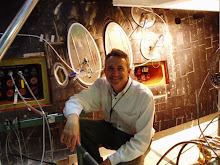Engineering projects evolve as designers assess and improve upon their work, and MLAS was no exception. The propulsion team's inventory of readily-available solid motors turned up a stockpile of Navy-surplus MK70 Terriers at the White Sands Test Facility (WSTF). This is the same motor used as a booster for several sounding rockets near and dear to modelers, including the Orion and Black Brant. A cluster of four Terriers would give us enough total impulse to meet our mission objectives and, since WSTF already had a stock in-hand, there would be no delay for procurement. So gone was the 8-motor cluster we had been considering -- µMRZ was suddenly obsolete.
It became even more obsolete when we considered carefully how a MLAS-type system might be used on a crewed flight vehicle (the objective of the project, or "objective" system). If the abort motors were placed next to the Orion SM, separation during an emergency was significantly complicated. The CM would have to be separated from the SM and the motors flown away from the stack without damage to themselves, the forward fairing, or the CM. Since baseline plans for Orion had the SM encapsulated in a fairing, the problem was even more complicated: we would have account for a "plunger effect" that would occur as the motors pulled free of that fairing or provide some means to alleviate it. There was room for our four Terriers in the forward fairing, providing we canted them so the motor casings roughly paralled the Outer Mold Line (OML) of the CM. The MK70's provided enough total impulse to fly the mission even allowing for the loss caused by mounting them off-axis, and the forward-mount allowed for clean separation at abort -- an objective system so-designed would not have to deal with the problems inherent in aft-mounted motors.

The third big change was driven as much by economics as engineering. We found we could procure a fiberglass fairing custom-manufactured by Northrop-Grumman's Gulfport, MS shipyard in any shape we wanted more quickly (and cheaply!) than buying one designed for the Atlas. Our concept demo was not weight-constrained as a crewed flight vehicle would be, and we didn't need the aerospace-quality Atlas fairing to meet our objectives. Fiberglass would be just fine. Our aerodynamics team recommended a Sears-Haack shape for minimum drag at our expected flight conditions. Thus, MLAS evolved to a four-motor flying nose cone ... and as it did, µMLAS Rev A was born.
Incidentally, the "Max" part of MLAS surfaced somewhere in the midst of the early discussions and design assessments.
Maxime Faget designed the tractor-rocket escape system flown on Mercury and Apollo and, in 1961, patented the "Aerial Capsule Emergency Separation Device" seen to the right. We named our alternate launch abort system in his honor ... thus MLAS.
 The results of Gordon's work are shown at right. The Forward Fairing and CM are both of fiberglass-over-foam construction in 1:20 scale to the actual MLAS. Gordon made the cylindrical section shown from a piece of 12" PML phenolic tubing by cutting out a section lengthwise, pulling the free edges together, and applying a fiberglass patch inside the tube. The CM was identical to the one he produced for µMRA with an open 2-1/2" core up the center, filled in this picture with a piece of scrap Estes BT-80. As with the previous parts, Gordon provided the fairing and CM primed and ready for finishing.
The results of Gordon's work are shown at right. The Forward Fairing and CM are both of fiberglass-over-foam construction in 1:20 scale to the actual MLAS. Gordon made the cylindrical section shown from a piece of 12" PML phenolic tubing by cutting out a section lengthwise, pulling the free edges together, and applying a fiberglass patch inside the tube. The CM was identical to the one he produced for µMRA with an open 2-1/2" core up the center, filled in this picture with a piece of scrap Estes BT-80. As with the previous parts, Gordon provided the fairing and CM primed and ready for finishing.








